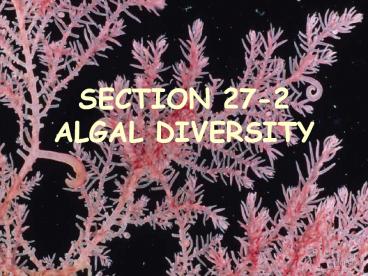SECTION 27-2 ALGAL DIVERSITY - PowerPoint PPT Presentation
1 / 21
Title:
SECTION 27-2 ALGAL DIVERSITY
Description:
B. EVOLUTIONARY HISTORY - green algae gave rise to land plants - both contain chlorophyll a and b ... Bioluminescent Costume Using Red Algae. VI. PHYLUM ... – PowerPoint PPT presentation
Number of Views:1321
Avg rating:3.0/5.0
Title: SECTION 27-2 ALGAL DIVERSITY
1
SECTION 27-2ALGAL DIVERSITY
2
I. PHYLUM CHLOROPHYTA - 7,000 species - green
algae A. HABITATS - most are aquatic, some
terrestrial -symbionts in invertebrate
cells -part of other organisms, lichens
3
B. EVOLUTIONARY HISTORY - green algae gave rise
to land plants - both contain chlorophyll a and
b - both contain carotenoids- store food as
starch - both have cell walls made of
cellulose II. PHYLUM PHAEOPHYTA - 1,500 species -
brown algae (include seaweeds and kelps) -store
food as laminarin - a carbohydrate
4
A. PIGMENTATION - all have chlorophylls a and c
and large amounts of fucoxanthin- gives a brown
color B. HABITAT - mostly marine - rocky coasts
with cool ocean water - few are far offshore
(Sargassum) in dense floating mats C. SIZE - all
multicellular - 45 -100 meters - Macrocystis
is the largest
5
Giant Kelp
6
D. SPECIALIZATION - holdfast - anchors thallus to
ocean bottom - stipe - stemlike portion - blade -
leaflike region modified to catch sunlight E.
NEAT STUFF - alginate- from cell walls, used in
drugs, cosmetics, food, ice cream III. PHYLUM
RHODOPHYTA - 4,000 species - red algae
7
A. PIGMENTATION - chlorophyll a -phycobilins-
absorb light for photosynthesis, allows them to
live at great depths (wavelengths) - depth
determines the pigments color B. HABITAT - most
are marine seaweeds - some in fresh water or on
land - found as deep as 200 m C. SIZE - smaller
than brown algae
8
Red Algae
9
More Red Algae
10
D. NEAT STUFF -carageenan- sticky substance that
coats some cell walls - used in making gelatin
capsules, cheese, and cosmetics - agar- extracted
from cell walls, used to make nutrient culture
for microbes IV. PHYLUM BACILLARIOPHYTA - 11,500
species -called diatoms - major producers of
organic matter in marine environments
11
Diatoms
12
Diatom
13
Diatoms
14
V. PHYLUM DINOFLAGELLATA - 1,100
species -dinoflagellates - most photosynthetic
but some are colorless and heterotrophic - cell
wall made of cellulose plates that look like
armor - 2 flagella of unequal lengths
15
Dinoflagellates
16
A. PIGMENTATION - yellowish-green to brown color
due to carotenoids - chlorophylls a and c B.
SPECIALIZATION - bioluminescence - produce light
at night, Noctiluca - red tide - population boom
of dinoflagellates that produce toxins and red
pigments - Gulf of Mexico and Florida
coast -shellfish eat this (toxins) and then
humans eat them dangerous
17
Red Tide
18
Bioluminescent Costume Using Red Algae
19
VI. PHYLUM CHRYSOPHYTA - 850 species - golden
algae A. PIGMENTATION -carotenoids (yellow /
brown) - chlorophyll a and c B. HABITAT - mostly
fresh water, few in marine C. SPECIALIZATION -prod
uce cysts- let them survive in frozen ponds
(winter) and dry lakes (summer)
20
- 2 flagella of unequal lengths - store surplus
energy as oil - contributes to petroleum
deposits VII. PHYLUM EUGLENOPHYTA - 1,000
species - euglena DONE
21
B. HABITAT - mostly fresh water -some in moist
environments (soil or digestive tracts) C.
EXAMPLE -Euglena - if raised in the dark then
wont form chloroplasts and become heterotrophic
END OF SECTION 27-2 !!































